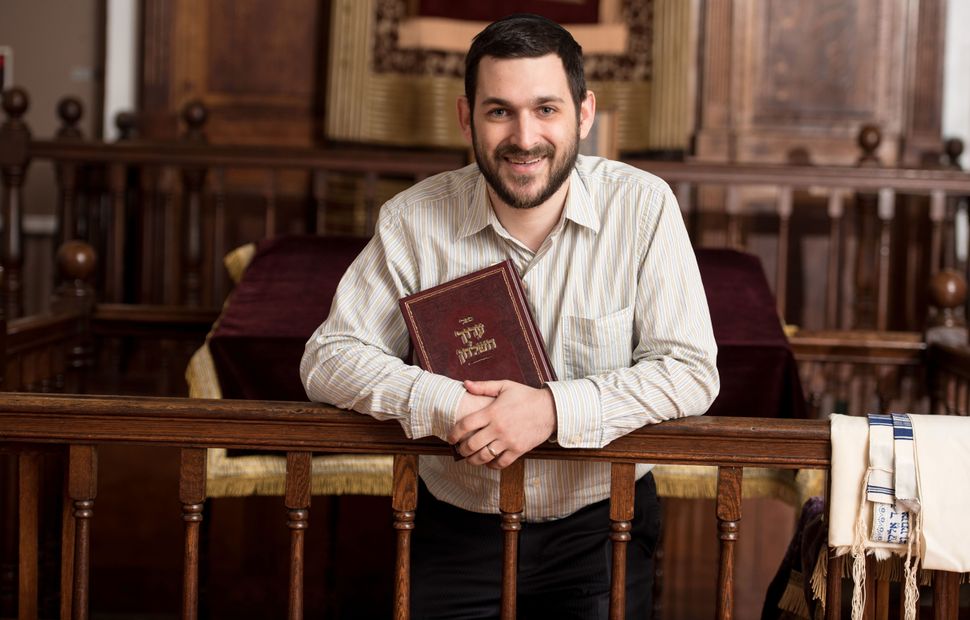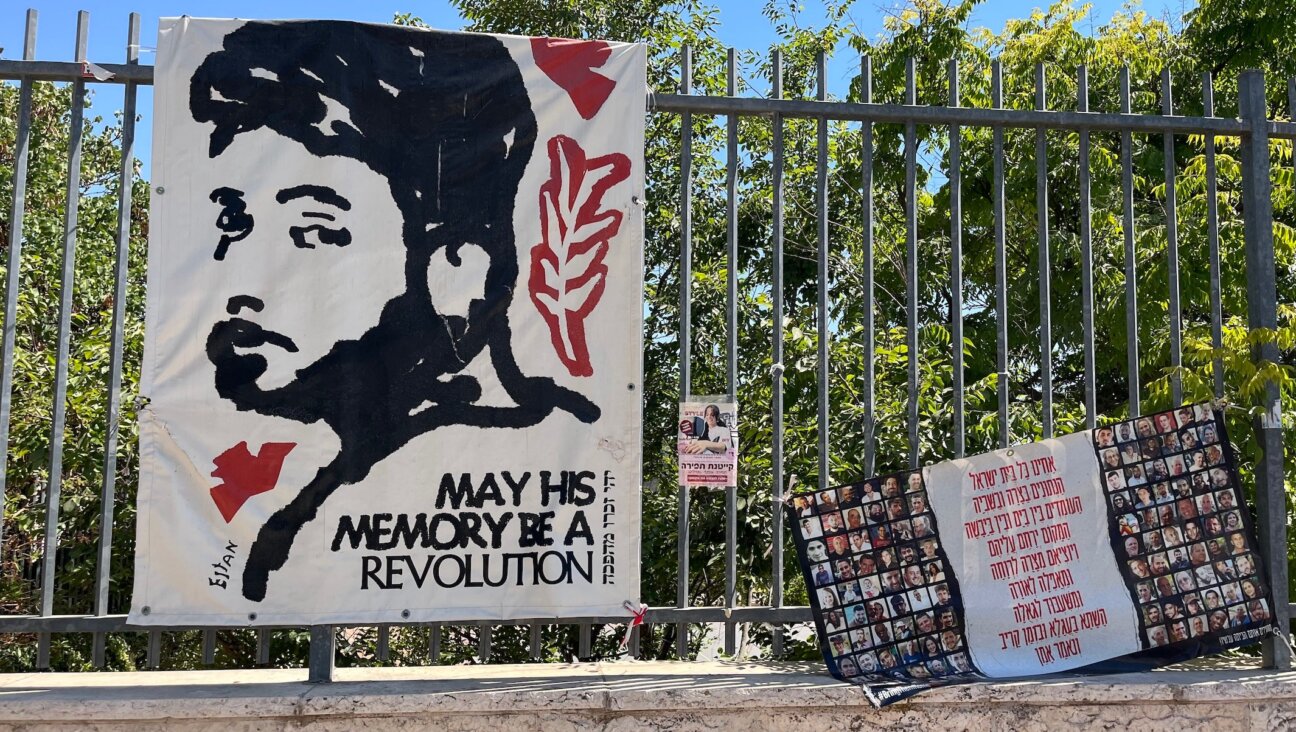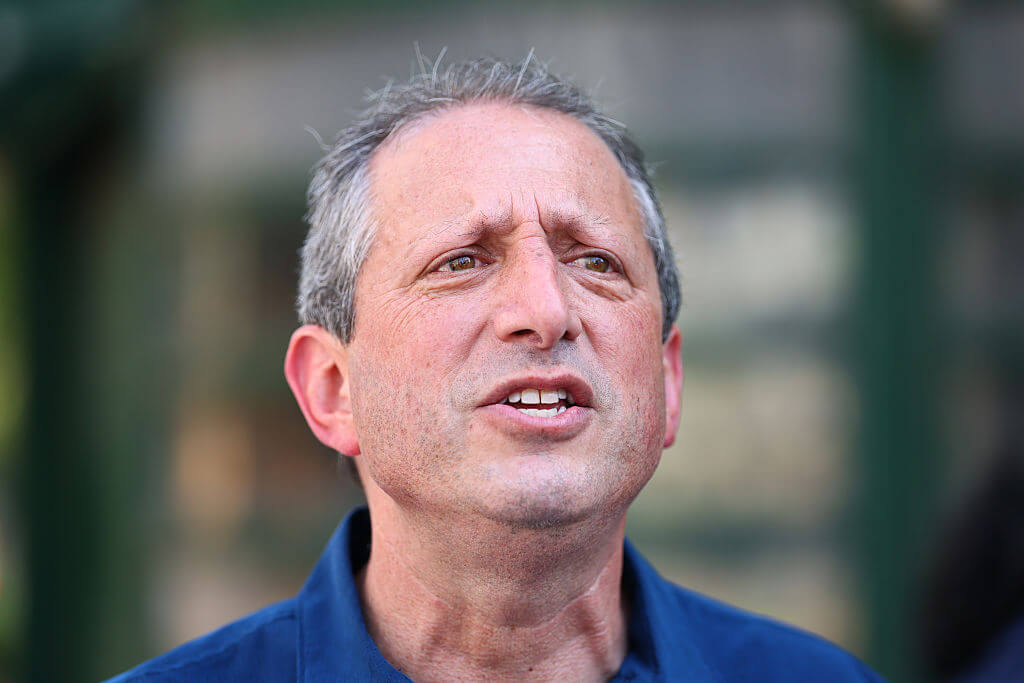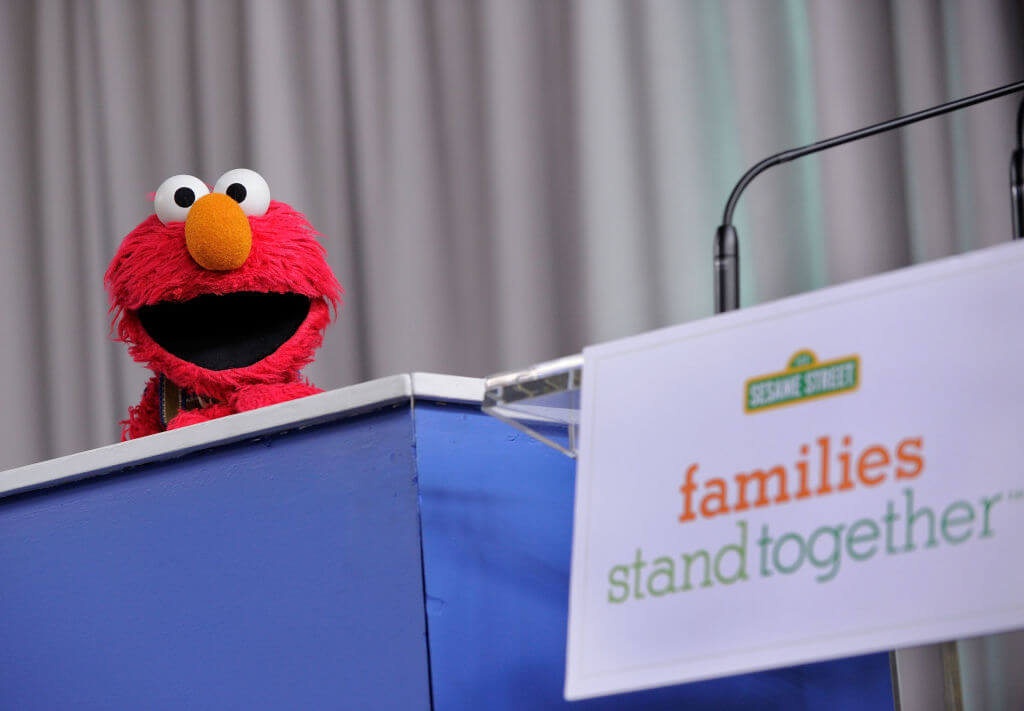Can This 28-Year-Old Rabbi Save A Landmark Brooklyn Synagogue?

Sam Reinstein of Kol Israel Image by Courtesy of Sam Reinstein and Kol Israel
When Rabbi Sam Reinstein arrived at the country’s first Jewish Comic Con, he didn’t seem to grasp the superhero symbolism emblazoned on his chest. A 28-year-old who prefers comedy to comics, he had decided to wear a humor T-shirt, which featured the Superman Logo wearing a black hat and peyes. He wandered through Congregation Kol Israel, his 90-something-year-old synagogue located on St. John’s Place in Brooklyn’s Crown Heights, saying hello and shaking hands with comic fanatics, oblivious to the fact that he may as well have introduced himself by simply pointing to his chest.
By day, Reinstein is a finance man who works at Prudential. At Kol Israel, working with paltry finances and modest resources, he’s been dealt the superhuman mission of transforming his ailing Modern Orthodox synagogue into a place young people consider cool.
Kol Israel has been on the verge of shuttering since the 1990s. There’s no air conditioning. On humid summer nights, congregants have to haul in floor fans to cool the place. Vandals shattered the stained-glass window over the front entrance, and the plastic replacement is now peeling. Several windowpanes downstairs are missing. The roof leaks. Tiles are cracked. A note on the hole-punched bathroom door reads, “Pardon our appearance, we’re remodeling.” I was advised not to linger on the third floor because of the risk of lead poisoning. Although the synagogue can hold 150 people, usually only about 30 attend Shabbat services.
Two years ago, after several failed attempts to bring in new members, the board hired Reinstein, who had not held a rabbinical position previously, to save the space and hopefully return it to its former glory.
Now, Reinstein says, Kol Israel’s “biggest fight” and obstacle is the “Jewish hipster” movement. Traditional synagogue settings have become less alluring for young Jews, who are gravitating toward alternative ways of observing Shabbat. Brooklyn in particular has seen a surge in homegrown efforts to bring Jewish prayer ceremonies out of the synagogue and into homier settings. Crown Heights was dubbed “Jewish hipster haven” in a recent JTA article.
“The old-hat Orthodox congregation is very boring and dull to those unfamiliar with it,” said Oscar Israelowitz, a columnist for the New York City Jewish Press and the author of Guide to Jewish New York City, speaking about the difficulties of attracting outsiders.
The Comic Con was part of Kol Israel’s plan to entice young people, Reinstein told me. Over the course of the day, about 100 people visited the narrow sanctuary to thumb through comic books, turn over merchandise, talk with vendors and listen to panelists like Mort Gerberg, the New Yorker cartoonist. It was the most visitors the synagogue has welcomed in years.
“You want something that feels new,” Reinstein said. “Because people are inundated with the same thing. I don’t think a synagogue is only about prayer and learning.”
At 4 p.m. it was time to pause for daily prayer. A congregant jumped on a wooden bench near the bimah and started waving his arms and yelling. It was hard to hear him over the din, but in an instant the cream lace scrim used on the Sabbath was wheeled to the center of the sanctuary, right down the middle of the “artist alley.” The vendors looked around. A dozen congregants grabbed prayer books and split to the men’s or women’s side of the screen. A Batman emblem poked out from under one man’s tallit. Another worshipper wore a tuxedo, presumably some sort of costume. A woman sitting in the foyer was putting on a foxy Black Canary outfit with knee-high heeled boots.
Reinstein began. Despite his usual laidback attitude, when he prays he spits out rapid-fire Hebrew and bows in quick, succinct juts. If you don’t know what’s going on, it can be hard to keep up.
Kol Israel has a somewhat depressing, and also vaguely defined, history. The story goes that the congregation formed in 1924 and the building was erected in 1927 on a $10 plot of land, but there’s no way to confirm this. At one point, so I’ve been told, someone unknowingly tossed out the only box of historical documents, which according to Israelowitz is not uncommon for synagogues to do. The National Register of Historic Places claims that this now-landmarked structure dates back to 1928. “I’ve heard 1924 and 1927. Say ‘1925’ and call it good,” Fred Polaniecki, the board president, told me.
Kol Israel blossomed during the “synagogue heyday” of Prospect Heights and Crown Heights in the 1920s and ’30s, when, Israelowitz said, “the whole gamut” of Jews — Orthodox, Conservative and Reform — lived side by side. According to legend, and also to Eliezer Abramsky, who grew up in Brownsville and has attended Kol Israel for 33 years, an old rivalry existed with a neighboring synagogue about where you could better hear the crack of the homeruns from Ebbets Field, home of the Brooklyn Dodgers. You can often find Abramsky holding court outside the Kol Israel gate and waving to the young, diverse residents that now occupy a gentrifying St. John’s Street. (On an unrelated note, Abramsky asked me to print his name here in case it helps him find a wife.)
Kol Israel’s “period of significance” ended in 1959, according to the national register document. This date coincides with the beginning of the white flight that took place in the 1960s when other ethnicities moved in and Jewish families left for the suburbs. By 1970, the neighborhood had flipped from 70% white, and mostly Jewish, to 70% black. The small synagogues in the area were razed or became churches. In 1976, only 20 families were paying dues at Kol Israel, according to a 2010 story in the Forward. A few decades later, the 1991 Crown Heights riots, a three-day standoff between the neighborhood’s Jewish and black residents, coincided with Kol Israel’s most desolate time. Ten men managed to hold minyan, the minimum number needed for a prayer group. They kept Kol Israel alive only because it has no mortgage. Polaniecki told me that even as little as 15 years ago, when he moved to the neighborhood, the synagogue “was on the fast track to the graveyard.”
Reinstein moved to the neighborhood unaware that it was an enclave of Jews and applied for the rabbi job after he saw the listing online. For 40 years Rabbi Elkanah Schwartz reigned over the synagogue, but now that he’s in his early 80s he rarely makes the trek to synagogue from his home in Boro Park. The board unanimously voted to hire Reinstein. They’ve kept Schwartz on as “senior rabbi,” but I have yet to see him anywhere other than when I saw him seated on a bench at the Comic Con.
Reinstein represents the kind of young, fresh new face the synagogue claims it needs. He’s an avid sports fan, partial to the Jets, Nets and Mets. He posts jokes on Facebook (“I am in an open box relationship with my cereals”) and shares memes. He’s married to Hannah Dreyfus, a staff writer at Jewish Week. The couple hosted several millennial friends at Seder this year, where the guests partook in a sing-along with Passover lyrics to the tune of famous songs with revised titles, such as “There’s No Seder Like Our Seder” and “Leaving on a Desert Plane.”
One of Reinstein’s recent sermons revolved around a “Curb Your Enthusiasm” episode. He makes house calls, visits the hospital, presides over the occasional circumcision ceremony and leads non-Jews in a conversion class via Google Hangouts. He has ambitions to revamp Kol Israel, including expanding and updating the “library,” which is just a few shelves in a back corner of the basement. He doesn’t always know the answer to a question about Jewish law, and on his first day on the job he worried that he might drop the Torah.
After we took a Saturday walk through the Brooklyn Botanical Gardens, he paused outside his apartment and said he had something to tell me. His tone sounded ominous, so I braced myself for bad news.
“I think the first time we met, I told you I was 26. I don’t know why I said that,” he said sheepishly. “I think I had just had my birthday or something, but I’m 27, not 26.”
It was the equivalent of the internet meme where someone tells his or her significant other, “We need to talk,” and then, after a long pause, adds, “So what are we eating for dinner?”
“Sam is not just a rabbi, he is also a full-time employee in a workplace that is not a Jewish workplace, and he understands what it means to find meaning in the drudgery of everyday life: taking the subway, getting to work, worrying abut the paycheck, finding an apartment in New York — all the things that are hard for millennials,” Dreyfus told me.
Aside from daily drudgeries, Reinstein still must face the fact that young people no longer spend as much time in religious settings as their elders do. A 2015 report by the Pew Research Center found that only 27% of millennials attend services on a weekly basis. Though according to a separate Pew report, 77% of Modern Orthodox Jews still think religion is “very important.”
“He has to have some tricks in his bag to really bring in the people. That’s the bottom line,” Israelowitz said. “If it’s food or a baseball game or barbecue, maybe it’ll bring people in, and throw in a little bit of prayers. Slowly but surely you’ll get a little people.”
Reinstein admires the comedian Myq (pronounced Mike) Kaplan and, through an acquaintance, was able to book him at Kol Israel this past February. About 60 people showed up, most of them in their 20s and 30s. While the attendees purchased bottles of beer and mingled like they were at a house party, Kaplan, a mousy man with wire glasses, stood alone by the bar, looking slightly out of place. The house was packed; almost every seat was occupied.
Reinstein hopped up on the bimah, which doubles as a stage for events, and introduced Eli Lebowicz, the opening act. Lebowicz spoke to a very specific, and not always universal, Jewish experience (“You know when you’re peeing and your yarmulke falls in the toilet?”). Reinstein then re-emerged and gushed about Kaplan in a fan boy moment. After Kaplan’s hourlong set, people stayed to bask in an atmosphere of elation while the comedian signed autographs in the foyer.
Since then, there have been monthly art shows and after-parties. At one after-party in June, which Reinstein missed because he had to stay with his 12-month-old son, Abramsky stood outside, chatting about how Kol Israel used to be a “boys club.” He retains an old-guard, traditional Orthodox attitude, preferring that women pray on the balcony rather than on the main floor. He worries that the synagogue will alter its practices to cater to the young people coming in.
As he talked, the feel-good funk music from the Brooklyn Jazz Warriors playing in the sanctuary spilled through the open door. Inside, a green-and-red disco light beamed across the darkened sanctuary, lit only by tea candles. Gold glitter was sprinkled across folding tables that had been draped with black coverings. Several young men and women smoked a hookah and bounced along to the band.
Each Saturday, more people are filling the sanctuary and the parties are better attended. Three girlfriends fresh out of college came to check out the place together last spring. A young bearded man joined recently, towing along his non-Jewish girlfriend. He left Orthodoxy as an adolescent, but picked Kol Israel because he liked Reinstein’s relaxed methods. Each week Reinstein meets someone new. They stick around through lunch to converse over homemade cholent ladled from a Crock-Pot.
Then one morning this summer, 60 people showed up to Shabbat, a near record by recent memory, shocking some of the elders, one of whom asked Reinstein, “Who are all these people?”
“I feel like this has been working,” Reinstein said to me later. “[Kol Israel] doesn’t feel dead and old. It’s gaining momentum. This is the first time this has happened.”
Britta Lokting, a former Forward culture fellow, was a 2017 3rd place award winner from the Religion Newswriters Association for her article “Is a Jewish Fraternity Like AEPi Only For Jews?”





















